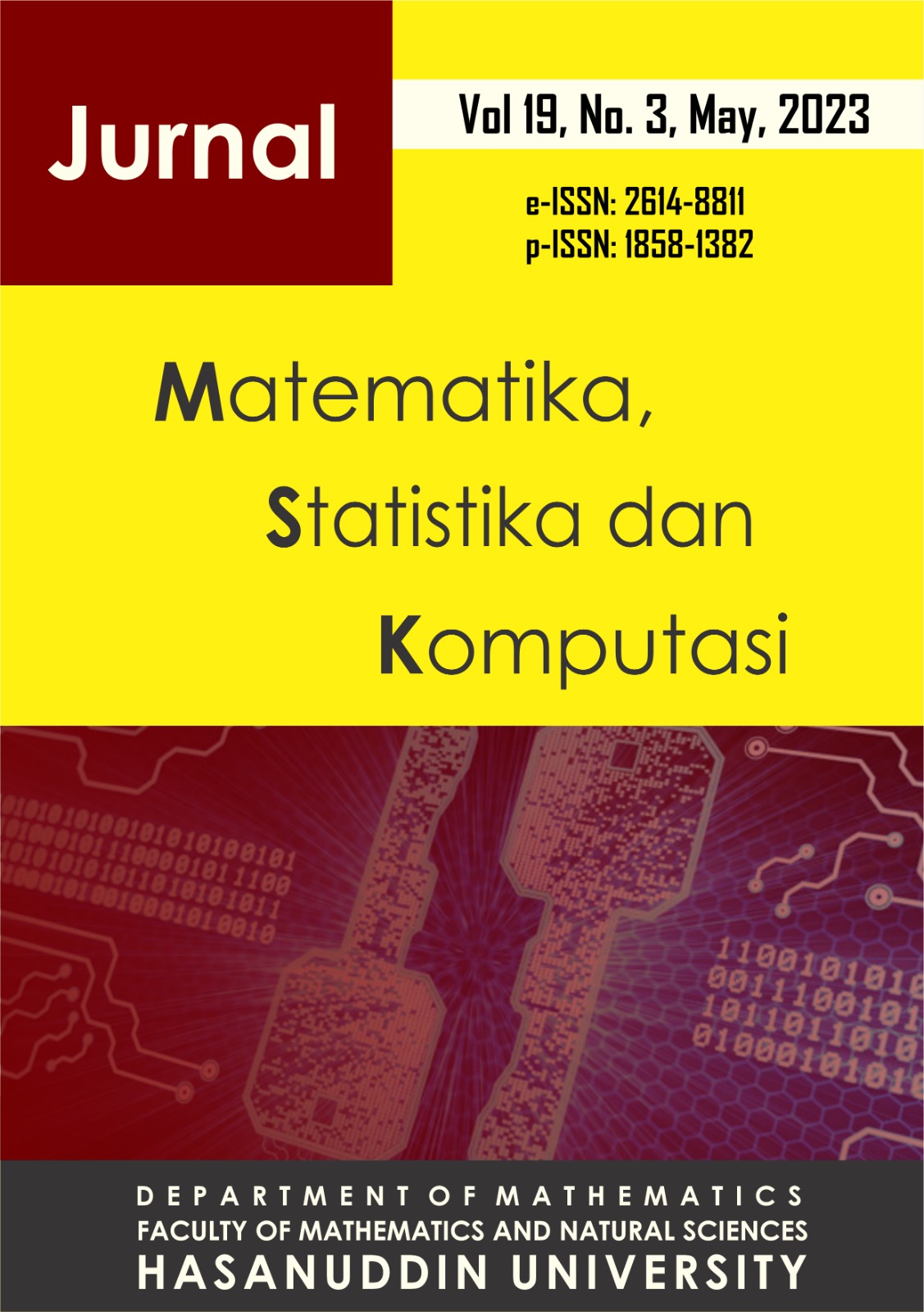Hopf Bifurcation in a Modified Leslie-Gower Two Preys One Predator Model and Holling Type II Functional Response with Harvesting and Time-Delay
DOI:
https://doi.org/10.20956/j.v19i3.24851Keywords:
Hopf bifurcation, Leslie-Gower, two preys, Holling type II, harvesting, time delayAbstract
In this paper, a modified Leslie-Gower two preys one predator model and Holling type II functional response with harvesting and time-delay were discussed. Model analysis is carried out by determining fixed points, then analyzing the stability of the fixed points and discussing the existence of the Hopf bifurcation. In some conditions that occur in nature indicate the occurrence of hunting of prey and predator species by humans. Therefore, this model is modified by adding the assumption that prey and predators are being harvested. Another modification given to the model is the use of time delays.The delay time term is for taking into account the case that the members of the predator species need time from birth to predation for being active predators. The first case is a model without time delay, it is obtained that 3 fixed points are unstable and 7 fixed points are stable. One of them is the interior fixed point tested with the Routh-Hurwitz criteria. The second case is a model with a delay time, the critical delay value is obained. Hopf bifurcation occurs when the delay time value is equal to the critical delay value and also fulfills the transversality condition. Observations on the model simulation are carried out by varying the value of the delay time. When the Hopf bifurcation occurs, the graph on the solution plane shows a constant oscillatory movement. If the value of the delay time given is less than the critical value of the delay, the controlled system solution goes to a balanced state. Then when the delay time value is greater than the critical delay value, the system solution continues to fluctuate causing an unstable system condition.
References
Aziz-Aloui, M. and Daher-Okiye, M., 2003. Boundedness and global stability for a predator-prey model with modified Leslie-Gower and Holling type-II. Schemes, Appl. Math. Lett., 16. 1069-1075
Banerjee, M. and Banerjee, S., 2012. Turing instabilities and spatio-temporal chaos in ratio-dependent Holling-Tanner model. Mathematical Bioscience, 236,64-76.
https://doi.org/10.1016/j.mbs.2011.12.005
Boyce, W. E. & DiPrima, R. C., 2009. Elementary differential equations and boundary value problems, Ninth Edition John Wiley & Sons, New York.
Du, N. H., Man, N. M & Trung, T. T., 2007. Dynamics of predator-prey population with modified Leslie-Gower and Holling-type II schemes, Acta Mathematica Vietnamica, Vol. 32, No.1, 99-111.
Gakkhar, S. and Naji, R.K., 2003. Order and Chaos in predator to prey ratio-dependent food chain, Chaos, Solitons and Fractals, 18, 229-239.
https://doi.org/10.1016/S0960-0779(02)00642-2
Hunsicker, M. E., et al., 2011. Functional responses and scaling in predator-prey interactions of marine fishes: Contemporary Issues and Emerging Concepts, Ecology Letters, Vol. 14, 1288-1299. https://doi.org/10.1111/j.1461-0248.2011.01696
Idels, L. V and Wong, M., 2008. Harvesting Fisheries Management Strategies with Modified Effort Function. IJMC.
Liang, Z. and Pan, H., 2007 Qualitative analysis of a ratio-dependent Holling-Tanner model, Journal of Mathematical Analysis and Application, 334,954-964.
https://doi.org/10.1016/j.jmaa.2006.12.079
Leslie, P. H., 1948. Some further notes on the use of matrices in population mathematics, Biometrika Vol. 35, No. 3/4, 213-245.
Leslie, P. H. & Gower, C., 1960. The properties of a stochastic model for the predator-prey type of interaction between two species, Biometrika, Vol. 47, No. 3/4, 219-234.
Liu, P. P. and Xue, Y., 2012. Spatiotemporal dynamics of predator-prey model, Nonlinear Dynamics, 69, 71-77.
Lotka, A. J., 1925. Elements of Physical Biology. William and Wilkins, Baltimore.
Lu, Z. and Liu, X., 2008. Analysis of a predator-prey model with modified Holling-Tanner functional response and time delay, Nonlinear Analysis: RealWorld Application, 9, 641-650.
Ma, Y., 2012. Global Hopf bifurcation in the Leslie–Gower predator–prey model with two delays, Nonlinear Analysis: Real World Applications, Vol. 13, 370-375.
Nindjin, A. F., A. Aziz-Aloui, M. A. & Cadivel, M., 2006. Analysis of a Predator–Prey Model with Modified Leslie–Gower and Holling-type II Schemes with Time Delay, Nonlinear Analysis: Real World Applications, Vol. 7, 1104-1118.
https://doi.org/10.1016/j.nonrwa.2005.10.003
Ren, X., Zhang, T. and Liu, X., 2020. Invasion waves for a diffusive predator-prey model with two preys and one predator. International Journal of Biomathematics, Vol 13, No. 18.
Saha, T. and Chakrabarti, C., 2009. Dynamical analysis of a delayed ratio-dependent Holling-Tanner predator-prey model, Journal of Mathematical Analysis and Applications, 358,389-402. https://doi.org/10.1016/j.jmaa.2009.03.072
Sakarya, S., 2021. Analysis of a prey-predator dynamics with a modified holling-tanner model and delay effect. Istanbul Teknik Universitesi.
Thakur, N. K., Ojha, A., Jana, D. and Upadhyay, R. K., 2020. Modeling the plankton-fish dynamics with top predator interference and multiple gestation delays, Nonlinear Dynamics, 100, 4003-4029.
Volterra, V. 1926. Variazioni e fluttuazioni del numero d’individui in specie animali conviventi. Memoria della Reale Accademia Nazionale dei Lincei, 2, 31-113.
Xie, X. and Zhang, W., 2017. Hopf bifurcations in a three-species food chain system with multiple delays, Open Mathematics, 15, 508-519.
Zhang, J. F., 2012. Bifurcation analysis of a modified Holling-Tanner predator-prey model with time delay, Applied Mathematical Modelling, 36,1219-1231.
Zhang, Z. and Yang, H., 2014. Hybrid control of Hopf bifurcation in a two prey one predator system with time delay. Proceedings of the 33rd Chinese Control Conference, pp. 6895-6900.
Downloads
Published
How to Cite
Issue
Section
License
Copyright (c) 2023 Author and publisher

This work is licensed under a Creative Commons Attribution 4.0 International License.

This work is licensed under a Creative Commons Attribution 4.0 International License.
Jurnal Matematika, Statistika dan Komputasi is an Open Access journal, all articles are distributed under the terms of the Creative Commons Attribution License, allowing third parties to copy and redistribute the material in any medium or format, transform, and build upon the material, provided the original work is properly cited and states its license. This license allows authors and readers to use all articles, data sets, graphics and appendices in data mining applications, search engines, web sites, blogs and other platforms by providing appropriate reference.







